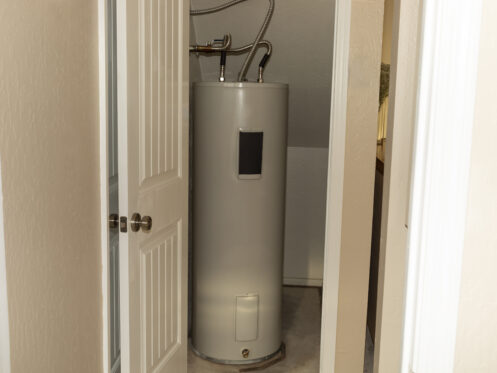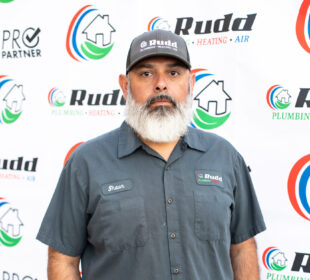Winter can be hard on your water heater. Spring is an excellent time to fix issues before the heightened household activity associated with warmer weather. Let’s explore the warning signs that something is wrong with your system and you need a plumber.
1. No Hot Water
Rule out a power outage. Check for a tripped circuit breaker, and be mindful that most modern gas water heaters need electricity to function, too. If applicable, check the pilot light. The problem could be the fuel, such as a closed or worn valve or running out of propane. You may have also experienced a faulty internal component. Common culprits include:
- Thermostats
- Thermocouples
- Heat exchangers
- Heating elements
- Pressure relief valves
2. Recurring Power or Combustion Issues
An isolated, tripped circuit breaker usually isn’t cause for concern. A recurring trip is, and you shouldn’t continue resetting it. It may just be you have a worn breaker that needs replacement. The issue could also be a damaged wire, a bad control board, or a faulty electric ignition system.
You may have a pilot light if you have an older fuel-burning system. A pilot light should always burn blue with perhaps a tinge of yellow at the tip. Other colors suggest a problem that requires the immediate attention of a plumber. Your pilot light may go out from time to time. That’s normal. What’s not normal is a pilot light that goes out frequently or is hard to relight.
3. Increased Energy Bills
Water heating can account for nearly 20% of the average household’s annual energy consumption. That’s why homeowners should track their energy use month to month and year to year. If you notice a spike in usage, it could be due to your water heater. Consider that scale can accumulate in a water heater and build up on heating elements and other parts. It acts like an insulator making the heat exchange less efficient and causing your costs to rise.
4. Inconsistent Temperatures
The Department of Energy recommends a water heater temperature setting of 120 degrees Fahrenheit for energy efficiency and safety. A well-functioning water heater will have no problem maintaining that temperature consistently. Even minor fluctuations can be a red flag. Sediment buildup can cause lower tank pressure and inconsistent heating. You may have a faulty dip tube, which is how cold water gets to the bottom of the tank. It may also suggest a problem with a vent pipe, thermostat, or heating element.
5. Running Out of Hot Water Prematurely
It’s normal to run out of hot water due to unusually high demand, such as when hosting family for the holidays. If your usage is normal and you run out, something is wrong. Often, it’s the same problems that cause inconsistent temperatures but just more evolved. Those may include sediment buildup and malfunctioning components, such as thermostats and dip tubes.
6. Leaking Water Heater
The average water heater in the U.S. can dump 40 to 50 gallons of water onto a floor quickly. It’s crucial to be vigilant for any signs of a leak. Some leaks will be obvious, such as water pooling around the tank base. Others may be less noticeable. Never ignore wet or dripping valves, for instance, no matter how seemingly insignificant the situation. A bad valve can result in a sizable leak in no time at all.
7. Unusual Noises
Modern water heaters are relatively quiet. You may hear a light buzz or hum when standing close, but that’s about the extent of it. Among the most worrying sounds is kettling, which is when a water heater sounds like a tea kettle heating water. Kettling occurs when sediment traps water at the bottom of the tank, causing it to overheat and boil. This creates popping or whistling sounds and may lead to pressure issues if left unaddressed. You should turn the water heater off and call a plumber.
Other noises that may indicate you need a repair include:
- Sizzling
- Popping
- Knocking
- Whistling
- Screeching
8. Discolored Hot Water
A reddish color to hot water often indicates rust. It may be that the sacrificial anode rod has corroded and needs replacement. The issue could be rust buildup in the tank itself. Trapped air can cause cloudiness, which should dissipate quickly. If the cloudiness persists, it could be due to limescale in the tank, gas in the water supply, or a bacterial buildup.
9. Smelly Hot Water
Smelly hot water is typically due to hydrogen sulfide gas, which gives off a rotten egg odor. The gas presence is the result of bacterial buildup in the tank. If you’ve been on vacation, you may just have to run the hot water for a while to clear it. Persistent odors may suggest the anode rod requires replacement. For more substantial buildups, our plumber will need to flush the tank and, in some cases, sanitize it.
10. Low Hot Water Pressure
If the hot water pressure is low but the cold water is fine, it’s usually a water heater problem. The issue can be sediment buildup in the water heater and even the pipes connected to it. It could also be a leak in the hot water supply line or a faulty pressure regulator. Can water heater problems cause low cold water pressure too? It isn’t common, but it can happen when limescale buildup from the water heater encroaches further into the plumbing system.
11. Slow Water Heater Recovery
Depending on the tank size and fuel type, most modern water heaters recover within 30 to 60 minutes. Gas heaters typically recover faster than electric models. If the household hasn’t changed but the recovery time has, there’s a problem. It can be one of the earliest signs that limescale accumulation within the tank is becoming severe. The slow recovery may also suggest a failing heating element, heat exchanger, or burner.
12. Excess Condensation
Light condensation on a water heater may not be a problem depending on the season and installation location. Excessive sweating is abnormal and can lead to rust and damage to your home. Condensation often forms when cold water enters a warm tank, especially in humid climates or poorly ventilated areas. It can even drip onto a pilot light and put it out. In some cases, it may be necessary to improve the water heater’s ventilation system. In others, the homeowner may need to correct high humidity within the water heater closet.
13. Visible Rust or Other Corrosion
Water heaters involve metal, water, and rust, which is an ideal setting for corrosion. Most corrosion will occur internally, which is one reason regular maintenance is so vital. Internal rust can eventually eat through to the exterior. On older water heaters, you’ll often see this corrosion around the tank base. If such rust is present, a leak is a matter of when and not if. You should also monitor for rust on valves and pipe connections. Its presence may indicate a small leak or that humidity levels in the area are too high. Homes in Charleston often deal with hard water, which can speed up sediment and limescale buildup that leads to corrosion over time.
Water Heater Repairs in Charleston
Rudd Plumbing, Heating, Air, and Electrical is a locally owned and operated residential plumbing contractor in Charleston, SC. Our team employs licensed plumbers who complete all water heater repairs to manufacturer specifications using quality parts and materials. We service all water heater technologies, brands, and models. Our company also backs our repairs and other services with a workmanship warranty and a 100% customer satisfaction guarantee. Call today with questions or to schedule an appointment.

